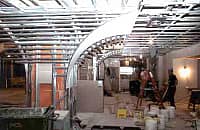FEATURES & BENEFITS

Cold-formed steel framed interior wall systems offer designers, owners, developers, and contractors many advantages. First, these systems offer design flexibility while providing improved sustainability and non-combustibility. Next, they provide assurance to the owner that indoor air quality standards and a shorter pay-back system solution have been met. Finally, to the contractor, a cold-formed steel framed interior wall solution provides a shorter construction cycle, with readily available, cost efficient building materials.
SUSTAINABILITY
Each individual component that comprises a cold-formed steel framed interior system helps support a sustainable design solution. The primary individual components of a cold-formed steel framed interior system include:
1) Gypsum Panels – From a recycling standpoint, for than 50 years, the gypsum industry has used recycled face and back papers for its face and back papers. The Gypsum Association has recently released an industry Environmental Product Declaration, EPD on gypsum products. This can be obtained from the Gypsum Association at https://gypsum.org/life-cycle-resources/.
2) Cavity Insulation – The National Insulation Manufacturers Association has devoted a portion of its website (www.naima.org) to system sustainability. The Association provides extensive information about glass fiber, rock wool, and slag wool type insulation. According to the National Insulation Manufacturers Association, “Using recycled materials in the manufacture of insulation prevents depletion of natural resources. Today’s fiber glass insulation can contain upwards of 70% recycled glass, but on average will typically contain 50% recycled glass. Slag wool insulation can contain up to 90% recycled content, but on average, uses approximately 70% blast furnace slag.”
3) Cold-Formed Steel Framing Sustainability –Steel is the world’s most recycled material (Source: World Steel Organization). Since 1990, the steel industry has reduced the amount of energy required to manufacture steel by 27%. In addition, all steel framing components have recycled content, and according to the AISC, this recycled content may be as high as 90%. Finally, 95% of the water used in steel production is recycled. The transition from the integrated process of making steel to the electric arc furnace has blanketed the North American continent with small energy efficient steel production plants. The U. S. Green Building Council, USGBC, has recognized the benefit of using regional materials in the LEED (Leadership in Energy and Environmental Design) certification program. To find more information about this topic, visit: www.steelframingassociation.org.
NON-COMBUSTIBLE
Most of the building materials, including gypsum panels, cement boards, rock wool insulation, steel framing, and stucco, commonly used in cold-formed steel framed systems are recognized by the model codes as non-combustible. Using non-combustible materials helps insure that the structure will meet or exceed life safety standards. Also, the use of non-combustible materials qualifies these assemblies in what the codes recognize as Type I buildings.
INNOVATION

The American Heritage College Dictionary (2004) defines innovation as “marked by or given to innovations” and “something newly introduced”. According to these definitions, cold-formed steel framed systems are uniquely innovative. Although fundamentally, cold-formed steel framing systems have been successfully used since the early 1960’s, material science and technology advances have elevated these systems literally to new and dynamic design heights. Many of the building materials (gypsum panels, steel framing, insulation and finishes) that comprise a cold-formed system have undergone significant transformation. These new advances have helped to create cold-formed steel systems with superior performance characteristics (fire, acoustics, structural, moisture, and aesthetics). The new system’s enhanced performance affords the architect greater design flexibility and almost renders the traditional systems obsolete.
AESTHETIC DESIGN FLEXIBILITY
The use of cold-formed steel framed systems provides the designer with almost limitless design flexibility. Interior walls and ceilings no longer need to be thought of as a flat plane. Instead, cold-formed steel framing systems can easily achieve a more sculptured, organic look. Further, there are many finishes available that are compatible with an interior cold-formed steel framed interior system. Plaster can produce either a smooth, slick surface or a textured finish, while tile and stone can also work well as a finish to the system.
LOW-COST, SHORT PAYBACK TIME
According to the 2011 R.S. Means Building Construction Cost Data, the use of an interior non-load bearing cold-formed steel framing provides the best production rate over wood framing and concrete block. For an 8” concrete block partition, it takes a crew of five workers (three bricklayers and two helpers) to install 275 square feet of steel framing. Two carpenters can install 800 square feet of 2×4 wood studs at 16 inches on center. One carpenter can install 925 square feet of cold-formed steel framing in a day (3-5/8” x 18mil x 24 inches on center).

